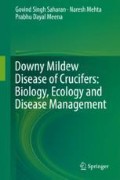Abstract
In epidemics of downy mildews, the pathogen population starts from a low level of initial inoculum which then increases exponentially through successive cycles on the host during the growing season. The seasonal increase of the pathogen population has been investigated much more thoroughly than that of the initial inoculum. Information has been generated on the multiplication phase of the disease, which relates to the sequence of events in the life of the pathogen on its host, which are infection, colonization, and sporulation. The studies on forecasting of crucifers’ downy mildew disease are limited to prediction models.
Access this chapter
Tax calculation will be finalised at checkout
Purchases are for personal use only
References
Achar PN (1998) Effects of temperature on germination of Peronospora parasitica conidia and infection of Brassica oleracea. J Phytopathol 146:137–141
Bains SS, Jhooty JS (1979) Mixed infections by Albugo candida and Peronospora parasitica on Brassica juncea inflorescence and their control. Indian Phytopath 32:268–271
Banerjee S, Bhattacharya I, Khan SA, Huda AKS (2010) Weather sensitivity of downy mildew and Alternaria blight of mustard in the gangetic west Bengal, India. J Sci Found 8:77–81
Butler EJ, Jones SQ (1949) Plant pathology. McMillan, London
Chou CK (1970) An electron-microscope study of host penetration and early stages of haustorium formation of Peronospora parasitica (Fr.) Tul. on cabbage cotyledons. Ann Bot 34:189–204
Chu HT (1935) Notes on the penetration phenomena and haustorium formation of Peronospora brassicae Gaum. Ann Phytopathol Soc Jpn 2:150–157
D'Ercole N (1975) Peronospora disease of cauliflower in north central Italy. Informatore Fitopatol 25:21–23
Eddins AH (1943) Control downy mildew of cabbage with Spergon and Fermate. Florida Agric Exp Stn Press Bull 589. 4p
Felton MW, Walker JC (1946) Environmental factors affecting downy mildew of cabbage. Aust J Agric Res 72:69–81
Hammarlund C (1931) Shorter mycological notices II. A giant form of Peronospora brassicae Gaumann (=P. parasitica (Fries) Tulasne) on Raphanus sativus f. radicula. Bot Notiser 5:392–393
Jiang Y, Caldwell CD (2015) Effect of nitrogen fertilization on Camelina seed yield, yield components, and downy mildew infection. Can J Plant Sci 96:17–26
Jonsson R (1966) Peronospora on oil yielding Brassicas. Methods for testing resistance in winter rape and their results. Sver Utsadestor Tidskr 76:54–62
Kolte SJ, Awasthi RP, Vishwanath (1986) Effect of planting dates and associated weather factors on staghead phase of white rust and downy mildew of rapeseed and mustard. Indian J Mycol Plant Pathol 16:94–102
Mehta N (1993) Epidemiology of white rust and downy mildew disease complex in mustard and residual toxicity of fungitoxicant. Ph.D. Thesis, CCS. Haryana Agricultural University, Hisar, Haryana, India: 154p
Mehta N, Saharan GS (1998) Effect of planting dates on infection and development of white rust and downy mildew disease complex in mustard. J Mycol Plant Pathol 28:259–265
Mehta N, Saharan GS, Sharma OP (1995) Influence of temperature and free moisture on the infection and development of downy mildew on mustard. Plant Dis Res 10:114–121
Nakov B (1972) The effect of ecological factors on the dissemination of Peronospora parasitica (Pers.) Fr. on cabbage. Nauch Trudov Vissh Selskostop Inst V Kolarov; Plovdiv 21:109–116
Natti JJ, Harvey GER, Sayre CB (1956) Factors contributing to the increase of downy mildew of broccoli in New York State and its control with fungicides and agrimycin. Plant Dis Report 40:118–124
Petraitiene E, Brazauskiene I (2005) Incidence and severity of Alternaria blight (Alternaria spp.) and downy mildew (Peronospora parasitica) as affected by winter oilseed rape sowing time and nitrogen fertilizer rate. Agronomijas Vestis (Latvian J Agro) 8:158–162
Quanjer HM (1928) The influence of potash deficiency on the susceptibility of cauliflower to Peronospora parasitica. Tijdschr, Over Plantenziekten 34:254–256
Saharan GS (1984) A review of research on rapeseed mustard pathology in India. Annual Workshop AICORPO ICAR, Jaipur, 6–10 August 1984
Saharan GS, Verma PR, Nashaat NI (1997) Monograph of downy mildew of crucifers. Saskatoon Res Cent Tech Bull, Agriculture and Agri-Food Canada, 1997–01, 197 pp
Sangeetha CG, Siddaramaiah AL (2007) Epidemiological studies of white rust, downy mildew and Alternaria blight of Indian mustard [Brassica juncea (Linn.) Czern & Coss.] African J Agric Res 2(7):305–308
Sinobas Alonso J, Diaz Alonso M (1995) The mildew of the crucifers in the term of villa del Prado (Madrid): epidemiological notes. Boletín de Sanidad Vegetal Plagas 21:497–506
Sochting HP, Verret JA (2004) Effects of cultivation systems: soil management, nitrogen fertilization on the epidemics of fungal diseases in oil seed rape (Brassica napus L. Var. napus). J Plant Dis Protect 111:1–29
Townsend GR (1935) Everglades Experimental Station. Report Florida Expt Stn 1933-34, pp. 86–112
Vladimirskaya ME, Ilyina MH, Klinkovskaya IK (1975) Forecasting disease incidence on cabbage crops as influenced with their cultivation practices. Mikol Fitopatol 9:130–132
Williams PH, Leung H (1981) Methods of breeding for multiple disease resistant Chinese cabbage. In: Talekar NS, Griggs TD (eds) Chinese cabbage. Proceedings of the 1st International Symposium. The Asian Vegetable Research and Development Center, Shanhua, Taiwan, pp 393–403
Author information
Authors and Affiliations
Rights and permissions
Copyright information
© 2017 Springer Nature Singapore Pte Ltd.
About this chapter
Cite this chapter
Saharan, G.S., Mehta, N., Meena, P.D. (2017). Epidemiology and Forecasting. In: Downy Mildew Disease of Crucifers: Biology, Ecology and Disease Management. Springer, Singapore. https://doi.org/10.1007/978-981-10-7500-1_9
Download citation
DOI: https://doi.org/10.1007/978-981-10-7500-1_9
Published:
Publisher Name: Springer, Singapore
Print ISBN: 978-981-10-7499-8
Online ISBN: 978-981-10-7500-1
eBook Packages: Biomedical and Life SciencesBiomedical and Life Sciences (R0)

